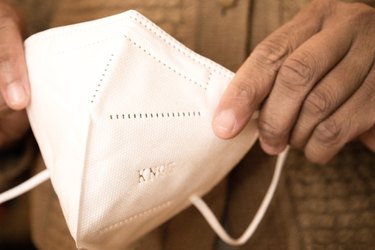
By now, you should almost be a face mask pro: Popping one on wherever you go, stashing extras in your car, etc. But with mask mandates changing, it can be tough to know exactly what you need to wear and when. We have some answers.
Keep in mind that the advice surrounding COVID-19 is constantly evolving. Per February 2022 guidelines from the Centers for Disease Control and Prevention (CDC), If you're feeling sick, have had a positive COVID-19 test or have been exposed to someone with COVID-19, you should mask up.
Video of the Day
Video of the Day
Otherwise, you should look at the total number of COVID cases and hospitalizations in your area (you can check that here) to determine whether or not to mask:
- Low: Masks are optional; use your best judgment.
- Medium: Mask up if you're immunocompromised or live with someone who is.
- High: Everyone should wear a mask in indoor public places.
Keep in mind, though, that masks are still required on public transportation as well as hospitals and medical settings.
Get tips on how to stay healthy, safe and sane during the novel coronavirus pandemic.
It's worth noting that there has been some pushback on these new guidelines from certain medical organizations, including the American Medical Association (AMA).
"Even as some jurisdictions lift masking requirements, we must grapple with the fact that millions of people in the U.S. are immunocompromised, more susceptible to severe COVID outcomes, or still too young to be eligible for the vaccine," AMA president Gerald E. Harmon, MD, said in a February 2022 statement. "In light of those facts, I personally will continue to wear a mask in most indoor public settings, and I urge all Americans to consider doing the same, especially in places like pharmacies, grocery stores, on public transportation— locations all of us, regardless of vaccination status or risk factors, must visit regularly."
Dr. Harmon went on to say: "Although masks may no longer be required indoors in many parts of the U.S., we know that wearing a well-fitted mask is an effective way to protect ourselves and our communities, including the most vulnerable, from COVID-19 — particularly in indoor settings when physical distancing is not possible."
Choose an N95 Mask
Cloth masks were the go-to for the majority of the pandemic, but the CDC updated its guidance in January 2022 to recommend respirators such as N95s and KN95s, which have better filtration and provide a higher level of protection against virus particles.
N95 masks filter out at least 95 percent of both large and small particles in the air, per the CDC. While they were reserved for frontline health care personnel earlier in the pandemic, they're now much more widely available.
Keep in mind, though: It's never appropriate to wear an N95 (or any other mask) with a valve on it. The valve allows viral particles from your nose and mouth to spray out into the surrounding air, putting people around you at risk.
What About Face Shields?
"There's not an instance that I can think of where wearing only a face shield is appropriate," says Colleen Nash, MD, MPH, an infectious disease doctor at Rush University Medical Center in Chicago. "But a face shield plus a mask is always reasonable," she adds.
The CDC agrees: Face shields are not a mask substitute, as they have large gaps that allow viral particles to escape.
If you work at a place where you readily interact with people every day, like a grocery store, then the addition of a face shield or goggles can give your eyes a layer of protection, too. While the nose and mouth are the biggest sources of viral transmission, the eyes are also a potential route.
You might also consider a face shield if you are interacting with someone who is deaf or hearing impaired, in which case, choose one that wraps around the sides of your face and extends below the chin or is hooded, suggests the CDC.
Bottom line: In general, if you're going to wear a face shield, wear it over an N95 mask.
How to Wear a Mask Properly
For the most protection for you and members of your community, make sure to do the following:
- Wear your mask over your nose and mouth. (Not below the nose!)
- Make sure it nicely hugs your face and chin. Masks with adjustable ear straps, nose wire and fitted chins can make this happen.
- Wash your hands or use a hand sanitizer before putting your mask on.
- Do not touch or adjust your mask while wearing it.
Read more stories to help you navigate the novel coronavirus pandemic:
- Centers for Disease Control and Prevention: “Personal Protective Equipment: Questions and Answers”
- Centers for Disease Control and Prevention: “Use and Care of Masks"
- Centers for Disease Control and Prevention: "Maximizing Fit for Cloth and Medical Procedure Masks to Improve Performance and Reduce SARS-CoV-2 Transmission and Exposure, 2021"
- Centers for Disease Control and Prevention: "Interim Public Health Recommendations for Fully Vaccinated People"
- Centers for Disease Control and Prevention: "Types of Masks and Respirators"
- American Medical Association: "AMA statement on CDC COVID-19 updates"
Is this an emergency? If you are experiencing serious medical symptoms, please see the National Library of Medicine’s list of signs you need emergency medical attention or call 911.